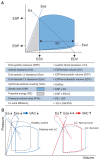Cardiovascular dysfunction and liver transplantation
- PMID: 29619780
- PMCID: PMC5903113
- DOI: 10.4097/kjae.2018.71.2.85
Cardiovascular dysfunction and liver transplantation
Abstract
Cardiovascular complications have emerged as the leading cause of death after liver transplantation, particularly among those with advanced liver cirrhosis. Therefore, a thorough and accurate cardiovascular evaluation with clear comprehension of cirrhotic cardiomyopathy is recommended for optimal anesthetic management. However, cirrhotic patients manifest cardiac dysfunction concomitant with pronounced systemic hemodynamic changes, characterized by hyperdynamic circulation such as increased cardiac output, high heart rate, and decreased systemic vascular resistance. These unique features mask significant manifestations of cardiac dysfunction at rest, which makes it difficult to accurately evaluate cardiovascular status. In this review, we have summarized the current knowledge of heart and liver interactions, focusing on the usefulness and limitations of cardiac evaluation tools for identifying high-risk patients.
Keywords: Autonomic nervous system; Cardiovascular dysfunction; Coronary artery disease; Echocardiography; Liver transplantation; Ventriculo-arterial coupling.
Figures

References
-
- Landesberg G, Beattie WS, Mosseri M, Jaffe AS, Alpert JS. Perioperative myocardial infarction. Circulation. 2009;119:2936–44. - PubMed
-
- Vernon G, Baranova A, Younossi ZM. Systematic review: the epidemiology and natural history of non-alcoholic fatty liver disease and nonalcoholic steatohepatitis in adults. Aliment Pharmacol Ther. 2011;34:274–85. - PubMed
-
- Anstee QM, Targher G, Day CP. Progression of NAFLD to diabetes mellitus, cardiovascular disease or cirrhosis. Nat Rev Gastroenterol Hepatol. 2013;10:330–44. - PubMed
Publication types
LinkOut - more resources
Full Text Sources
Other Literature Sources

